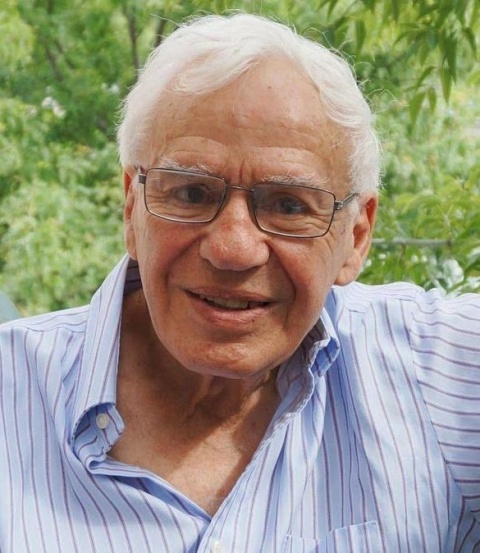Columbia College | Columbia University in the City of New York
George S. Zimbel ’51, Photographer of People in the Act of Living

A freelance photographer whose work appeared regularly in The New York Times, Look, Redbook, Architectural Digest and Saturday Review, Zimbel had three shows at the Stephen Bulger Gallery in Toronto. “Other photographers in the 1950s had a suspicious view,” Bulger told the Times. “But George loved to show the best in a situation, which is what he was like as a person.”
Zimbel liked to roam the streets and shoot ordinary people doing ordinary things: children at play, a woman pushing a stroller, a flower girl waiting amidst a wedding party, subway riders on their way home from work.
His work has been exhibited in the United States, Canada, Japan, France and Spain. Three of his photographs are in the collection of the Museum of Modern Art in New York, including one taken at an Irish dance hall in the Bronx in 1954. A young man with tousled hair is in the foreground, his head turned toward a group of women standing in the background. Is he about to ask one of them to dance? Do they even want him to ask? It is left to the viewer to decide.
Later that year, Zimbel was one of several photographers to record a more famous moment at a press event during the filming of Billy Wilder’s The Seven Year Itch: Monroe standing on a subway grate on Lexington Avenue and 52nd Street while a fan blew from beneath, billowing her dress and revealing her underwear. “This was the greatest publicity stunt ever created,” Zimbel said in The Night I Shot Marilyn (2016), a short documentary directed by his son, Matt Zimbel, and Jean François Gratton. “Still photographers were just eating it up.”
Nonetheless, Zimbel did not immediately publish any of his photos from that shoot. He didn’t even look at the negatives for 22 years, but eventually began to sell the images, which were included in several exhibitions and in the book Momento: Photographs of George S. Zimbel (2015).
Six years later, Zimbel photographed Kennedy, then a senator from Massachusetts, and his wife, Jacqueline, waving to a crowd from an open convertible in Manhattan late in the 1960 presidential campaign. “The more you look at that picture, the more it gives you the willies,” he said in the film Zimbelism: George S. Zimbel’s 70 Years of Photography (2015), also directed by Matt Zimbel and Gratton. “You could never do that picture again. You could never get that close.”
Born on July 15, 1929, in Woburn, Mass., Zimbel was fascinated by the photographs he discovered in the pages of Life and Look as a child. At 14 he obtained a Speed Graphic camera and began taking pictures for his high school newspaper. He continued to shoot for Spectator, where he was city editor as well as photographer; in his sophomore year, one of his photos was published in Life.
“You have to know about the world before you can photograph it intellectually,” reflected Zimbel, citing his studies with such Columbia professors as Charles Van Doren GSAS’59 and Charles Frankel ’37, GSAS’46 as “an absolute turning point of my life.”
While at the College, he also studied at The Photo League, a cooperative of photographers, and credits that experience for impressing upon him the importance of photographic basics like developing and print-making. “My work begins with recording an image,” he explained, “but it is not finished until I have made a fine print. That is my photograph.”
Upon graduation, Zimbel won a scholarship to study at the New School under photographer Alexy Brodovitch, who was then the celebrated art director of Harper’s Bazaar. After two years in the Army in Europe during the Korean War, he embarked on his 70-year career as a documentary photographer, as he defined himself. Zimbel moved to Canada in 1971 as a protest against the Vietnam War and lived on a farm on Prince Edward Island before moving to Montreal nine years later and eventually becoming a Canadian citizen.
Zimbel was predeceased by his wife, Elaine Sernovitz Zimbel, in 2017. He is survived by his sons, Andrew, Matt and Ike; daughter, Jodi; sister, Judi Goldman; and nine grandchildren.
— Alex Sachare ’71
Issue Contents
Published three times a year by Columbia College for alumni, students, faculty, parents and friends.
Columbia Alumni Center
622 W. 113th St., MC 4530, 6th Fl.
New York, NY 10025
212-851-7852
cct@columbia.edu
Columbia Alumni Center
622 W. 113th St., MC 4530, 4th Fl.
New York, NY 10025
212-851-7488
ccalumni@columbia.edu

